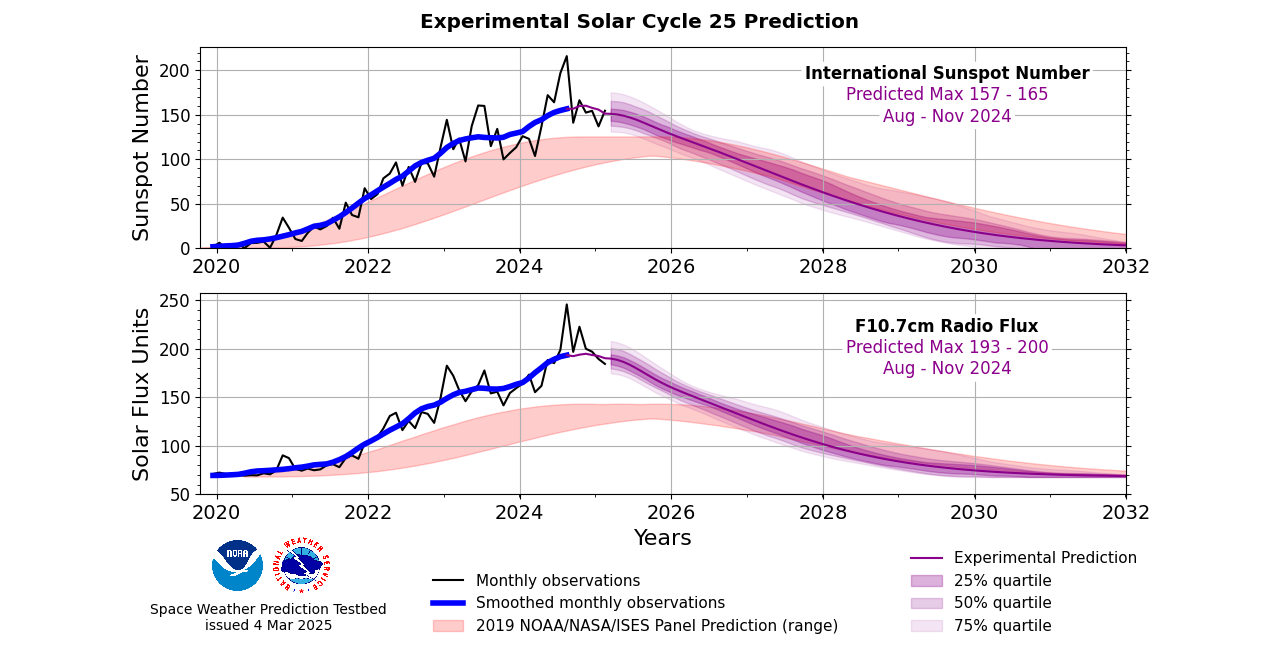
Since the Solar Cycle was discovered over 180 years ago, its progression has been monitored by counting the number of sunspots and sunspot groups visible (through a solar telescope) on the solar surface each day. These daily measurements are compiled into a monthly average and graphed as a function of time, as indicated by the black line in the top Figure (Figure 1). The blue line is a smoothed version of the this observed sunspot number, obtained by applying a 13-month average to each point in the black curve.
Though other quantitative measures of solar cycle progression exist, none has the 400-year history of the sunspot number. In the past few decades there has been a focused effort to standardize and calibrate how the sunspot number is calculated. This effort is reflected in the International Sunspot Number, which is maintained and distributed by the Solar Influences Data Analysis Center (SIDC) at the Royal Observatory of Belgium.
The frequency and severity of solar storms such as flares and coronal mass ejections increases with the sunspot number. Having a reliable forecast of what the sunspot number is likely to be several months or years from now is therefore valuable for space weather customers. The maximum value of the smoothed sunspot number reached in each cycle is referred to as the cycle amplitude, or strength. Amplitudes vary from cycle to cycle, with an average value of 178.
In 2018-2019, NOAA, NASA, and the International Space Environment Service (ISES) convened an international panel to predict the amplitude of Solar Cycle 25 and the date at which solar maximum will occur. The panel solicited for community input and received nearly 50 distinct predictions that were synthesized into a single prediction, with a range of uncertainty. The uncertainty range of the panel prediction, issued in 2019, is shown as the shaded red area in Figure 1.
Within several years, it became clear that this panel prediction was too low, just beyond the estimated range of uncertainty. Though it is still interesting from a scientific standpoint to compare the observed progression with the prediction made before the cycle started, a more reliable forecast is needed to accurately assess the potential for space weather hazards.
An updated forecast for the amplitude and timing of Solar Cycle 25 is shown by the magenta line in Figure 1. This is obtained by applying a curve fit to the available observational data (black line) based on the same function that was used to produce the red line. In other words, the parameters in the panel prediction are adjusted to better match the observed sunspot number data. An average is then computed between the current fit and one made without the most recent nine months of data. This makes the prediction more robust to short-term trends. A new prediction is made in this way every month as new data become available.
The shaded regions show the uncertainty in the prediction, obtained by applying the same prediction method to previous cycles at the same stage in each cycle (measured in months since cycle beginning). In particular, the three shades show the first three quartiles of the deviations from previous predictions.
So, this should be interpreted as follows. There is roughly a 25% chance that the smoothed sunspot number will fall within the dark shaded region at a particular time in the future. Similarly, there is a 50% chance the smoothed sunspot number will fall in the medium-shaded region and a 75% chance it will fall in the lightest of the shaded regions.
Figure 2 (bottom) shows a similar prediction made for the solar emission of radio waves in the 10.7 cm (2800 MHz) band. This is often referred to as the F10.7 radio flux and it is found to be highly correlated with solar activity, making it another excellent way to follow the progression of the solar cycle.
As in Figure 1, the black line in Figure 2 represents observations compiled over the course of each month and the blue line represents a 13-month smoothing of these observations. These observations are provided by the Dominion Radio Astrophysical Observatory in Penticton, British Columbia, Canada. The F10.7 radio flux is traditionally given in solar flux units (1 sfu = 1.e-22 Watt per square meter per Hz).
The range of the 2019 panel prediction (red shaded area) for the F10.7 radio flux in Figure 2 is obtained by applying a conversion to the sunspot number prediction indicated by the red area in Figure 1. The conversion function is a fourth-order polynomial that is calibrated with empirical data.
The quartiles for the updated prediction (magenta shaded region) are obtained by applying the same conversion function to the corresponding sunspot number quartile deviations in Figure 1. The updated prediction itself (magenta line) is obtained via a direct fit to the observed monthly F10.7 data.
The latest predictions for both sunspot number and F10.7 radio flux are provided in the following json file. The high and low values included in this file are those for the 50% quartile (median deviation).
For further information on the observation sources and access to data, see SWPC's Solar Cycle Progression Website.
For technical details on the prediction method and for application to previous cycles, see the accompanying validation document:
Please direct all comments and questions to mark.miesch@noaa.gov (307-438-9522).